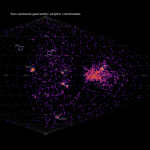Denis Vida points our attention at a recently published meteor related paper.
Estimating trajectories of meteors: an observational Monte Carlo approach – I. Theory
This paper has been submitted for publication to the Monthly Notices of the Royal Astronomical Society by Denis Vida, Peter S. Gural, Peter G. Brown, Margaret Campbell-Brown and Paul Wiegert.
Abstract: It has recently been shown by Egal et al. (2017) that some types of existing meteor in-atmosphere trajectory estimation methods may be less accurate than others, particularly when applied to high precision optical measurements. The comparative performance of trajectory solution methods has previously only been examined for a small number of cases. Besides the radiant, orbital accuracy depends on the estimation of pre-atmosphere velocities, which have both random and systematic biases. Thus it is critical to understand the uncertainty in velocity measurement inherent to each trajectory estimation method.
In this first of a series of two papers, we introduce a novel meteor trajectory estimation method which uses the observed dynamics of meteors across stations as a global optimization function and which does not require either a theoretical or empirical flight model to solve for velocity. We also develop a 3D observational meteor trajectory simulator that uses a meteor ablation model to replicate the dynamics of meteoroid flight, as a means to validate different trajectory solvers.
We both test this new method and compare it to other methods, using synthetic meteors from three major showers spanning a wide range of velocities and geometries (Draconids, Geminids, Perseids). We determine which meteor trajectory solving algorithm performs better for: all-sky, moderate field of view, and high-precision narrowfield optical meteor detection systems. The results are presented in the second paper in this series. Finally, we give detailed equations for estimating meteor trajectories and analytically computing meteoroid orbits, and provide the Python code of the methodology as open source software.
You can download this paper for free: https://arxiv.org/pdf/1911.02979.pdf (20 pages).
Older meteor library news:
2019
- Meteor shower activity profiles and the use of orbital dissimilarity (D) criteria, by Althea V. Moorhead. (25 October 2019).
- A fireball and potentially hazardous binary near-Earth asteroid (164121) 2003 YT1, by Toshihiro Kasuga, Mikiya Sato, Masayoshi Ueda, Yasunori Fujiwara, Chie Tsuchiya, and Jun-ichi Watanabe. (18 October 2019).
- Spectral and orbital survey of medium-sized meteoroids, by Pavol Matlovic, Juraj Tóth, Regina Rudawska, Leonard Kornoš and Adriana Pisarcíková. (7 August 2019).
- Rising from Ashes or Dying Flash? Mega Outburst of Small Comet 289P/Blanpain in 2013, by Quanzhi Ye (叶泉志) and David L. Clark. (19 June 2019).
- Discovery of a Meteor of Interstellar Origin, by Amir Siraj and Abraham Loeb. (10 June 2019).
- A Mathematical Model for Simulating Meteor Showers, by M. Cardinot and A. Namen. (4 June 2019).
- The 2019 Taurid resonant swarm: prospects for ground detection of small NEOs, by David Clark, Paul Wiegert and Peter G. Brown. (28 May 2019).
- Analysis of the June 2, 2016 bolide event over Arizona, by Csaba Palotai, Ramanakumar Sankar, Dwayne L. Free, J. Andreas Howell, Elena Botella and Daniel Batcheldor. (25 May 2019).
- Identifying Interstellar Objects Trapped in the Solar System through Their Orbital Parameters, by Amir Siraj and Abraham Loeb. (5 May 2019).
- Meteor Shower Modeling: Past and Future Draconid Outbursts, by A. Egal, P. Wiegert, P. G. Brown, D. E. Moser, M. Campbell-Brown, A. Moorhead, S. Ehlert and N. Moticska. (1 May 2019).
- Meteoroid structure and fragmentation, by M. D. Campbell-Brown. (24 March 2019).
- Solar cycle variation in radar meteor rates, by M. D. Campbell-Brown. (26 February 2019).
- A New Meteoroid Model, by Valeri V. Dikarev, Eberhard Grün, William J. Baggaley, David P. Galligan, Markus Landgraf, Rüdiger Jehn. (12 February 2019).
- Lunar impacts, by Costantino Sigismondi. (12 February 2019).
- Lunar impact flashes, by C. Avdellidou and J. Vaubaillon. (10 February 2019).
- The Geminid parent body: (3200) Phaethon, by Patrick A. Taylor, Edgard G. Rivera-Valentín, Lance A.M. Benner, Sean E. Marshall, Anne K. Virkki, Flaviane C.F. Venditti, Luisa F. Zambrano-Marin, Sriram S. Bhiravarasu, Betzaida Aponte-Hernandez, Carolina Rodriguez Sanchez-Vahamonde and Jon D. Giorgini. (10 February 2019).
- Sun approaching asteroids and meteor streams, by Quanzhi Ye and Mikael Granvik. (10 February 2019).
2018
- Waiting to make an impact: A probable excess of near-Earth asteroids in 2018 LA-like orbits, by C. de la Fuente Marcos and R. de la Fuente Marcos. (18 December 2018).
- What mechanisms dominate the activity of Geminid Parent (3200) Phaethon?, by LiangLiang Yu, Wing-Huen Ip and Tilman Spohn. (6 November 2018).
- The Draconid meteoroid stream 2018: prospects for satellite impact detection, by Auriane Egal, Paul Wiegert, Peter G. Brown, Danielle E. Moser, Althea V. Moorhead and William J. Cooke (21 September 2018).
- Modeling the measurement accuracy of pre-atmosphere velocities of meteoroids, by Denis Vida, Peter G. Brown and Margaret Campbell-Brown (15 July 2018).
2017
- The Mayas and Eta Aquariids in AD 250-909, by J.H. Kinsman and D.J. Asher (31 July 2017).





